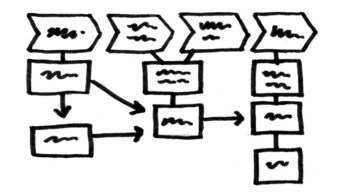This morning (Down Under) saw me back in our Ask the UXperts chatroom. This time I was joined by the lovely Marli Mesibov, Managing Editor of UX Booth. Marli is a content strategist with a background in UX, and she did herself credit today, churning out extensive and well thought out answers at the speed of lightning. I suspect her keyboard may now need replacing.
The premise behind Ask the UXperts is one expert, one hour, all your questions answered. The subject of content strategy is a broad one, but Marli managed to distill it into an informative 60 minute chunk, and for that I am grateful.
If you didn’t make the session because you didn’t know about it, make sure you join our community to get updates of upcoming sessions. If you’re interesting in seeing just what we discussed, or you want to revisit your own questions, here is a full transcript for your reading pleasure.
| HAWK | First up, I want to say a huge welcome and thanks to Marli for her time today. For those of you that aren’t familiar with Marli or her work, you can find her here http://www.uxbooth.com/author/marlimesibov/ |
So now I’ll ask Marli to give us a quick intro to the subject and then I’ll throw it open to you for questions | |
I’ll post a full transcript up on uxmastery later today | |
So Marli, the floor is yours… | |
| Marli M. | Thanks Sarah |
I’m a full time content strategist, but I came to content strategy through UX (user experience). I’ve found that a lot of people who work with content have a lot of questions about how we fit research and UX practices into our content work, and a lot of people who work in UX have questions or assumptions about how content plays a role, so I spend a lot of my time thinking about that intersection, and working with companies on how to create engaging content as part of a bigger experience. | |
| HAWK | That intersection is definitely something that I’ve wondered about |
| Marli M. | So in short, I’m here today to answer any questions you have about content, the strategies around content (its creation and its upkeep), and how that fits in with creating experiences. |
| HAWK | Excellent. If anyone wants to jump in with a question, now would be the time to do so. |
If things get busy, I’ll queue them for Marli. | |
If things are slow, I’ll get all my own questions answered ;) | |
| KB | Marli, can you just give some general advice about some key things to keep in mind about the sales cycle in relation to content strategies? |
| maadonna | I have one. What does a ‘normal’ engagement look like – what kinds of activities do you do? |
| Deb A. | how do you go about getting the people with the money to take content strategy seriously and provide resources and time? |
| KimberleyM | Marli, what kind of metrics do you use to ascertain whether your content strategy has worked for a client? |
| Deb A. | metrics is a good question kimberley |
| Marli M. | @KB Absolutely. Sales and marketing is a really interesting place for content right now – a lot of content strategists got started in marketing, so many of the best practices available start from the assumption that we’re making a sale. But sales speak isn’t particularly effective when your audience is being bombarded by ads all across the Internet, television, etc. So to create a more effective strategy, you would want to start by asking “who am I talking to?” and then “what do they need? what keeps them up at night?” Do the research, keep an open mind, and focus more on what is valuable to the audience than what your company wants to say or sell. |
| KB | Ok, I guess I’m thinking more in terms of inbound marketing and how to craft that content so it is part of the “exchange” process with prospective clients. In other words, how to best tie it to what you are “selling.” eBooks and such . . . |
| Josh | Q. Why have a content strategy, what’s the purpose especially for intranets? |
| Marli M. | maadonna: What does “normal” engagement look like? That’s a tricky question! Content strategy is still evolving, and as a result there is no normal just yet. For me, I look at what the problem is first, so I start off my projects with user research – interviewing prospective users, interviewing stakeholders, learning everything I can about the vocabulary they use and their interests and needs. Then I identify a solution – it might involve me writing copy, or it might involve me creating brand and editorial guidelines to pass along to copywriters or designers. Sometimes I work hand in hand with a design or development team, and I put together a user flow showing what messages the user should see/hear at each point of their journey. I think the only “normal” in content strategy so far is that every process will involve what content the user will respond to, and will leave the client or project with a plan for when to create new content and how to keep all the content relevant. |
| Steve W. | on the back of that question from KB..what would be the fundamentals that make an effective content strategy? |
| maadonna | Thanks. That’s good :) |
| Marli M. | Deb Armenante: “how do you go about getting the people with the money to take content strategy seriously and provide resources and time?” Great question. For most money people it comes down to the ROI. They need to see what they’ll get in return for content strategy. Sometimes it’s tough, because we’re delivering a process rather than one set deliverable (like “a website” or “a page of copy”), but if we can look at their current site conversions, for example, or their audience engagement, or any other metric and identify a goal, then they have something measurable to consider. It makes content strategy feel less fluffy to them and more valuable. |
| Deb A. | thanks Marli |
| JohnLacey | What’s the role of a content calendar? |
| Marli M. | KimberleyM: “what kind of metrics do you use to ascertain whether your content strategy has worked for a client?” It depends on what the client’s goals are. If an organization is trying to build a community, then it’s point blank: how many people are coming to the site and commenting or emailing or sharing. But if the goal is more nebulous, for example if a company is hoping to “become a leader” then I try to break down how we can identify that we have succeeded. Will we know we’re a leader when we have 10,000 Twitter followers? Or when we have a 10% conversion rate? I try to find the metric that most aligns with their needs. |
| KimberleyM | Cool, so where do you get your goal benchmarks from? How is 10,000 Twitter followers more “market leading” than 5,000 for example. Do you look at your competitors for comparison? |
| Deb A. | Do you think there’s a difference between content strategy and information management strategy? |
| Marli M. | @KB “(In response to your first answer about sales/marketing) Ok, I guess I’m thinking more in terms of inbound marketing and how to craft that content so it is part of the “exchange” process with prospective clients. In other words, how to best tie it to what you are “selling.” eBooks and such . . .” I think I understand – but let me know if I’m still not answering this KB. You’re looking for advice on how to craft content such that it connects with customers? I would suggest looking for where the users spend their time. If they’re on Twitter, you’re on Twitter. If they’re using Quora, they might be more intrigued by an eBook. If they’re on Instagram, see if that will translate well to an online community on your site. But if they are on the New York Times every day, stop looking for networking connections and provide them with straight up articles and videos. Is that more to your point? |
| KB | Yes, @Marli, that is good. Thank you. |
| Marli M. | Josh: “Why have a content strategy, what’s the purpose especially for intranets?” You don’t need a content strategy. You need a solution to whatever’s not going as well as you want it to, and sometimes the solution is a content strategy. It’s particularly useful if your company is looking to engage with a new audience, or if your company is putting a lot of time/money into content and not seeing any response. Those are situations where putting together a strategy will identify the holes (why aren’t people engaging? Why isn’t the content getting responses?) and likely patch them. |
I’ll add that it’s especially important for intranets because everything is content today! We’re in a chat right now – it’s all text, nothing ephemeral. This is content. With so much noise all around, if your content doesn’t have a strategy it’ll get lost. | |
@Steve W: “on the back of that question from KB..what would be the fundamentals that make an effective content strategy?” (1) Specificity is key. Every organization has a unique personality, so an effective content strategy is going to be specific to them. (2)User research is very important, and all the things that make it “strategy” rather than just a cloud of content – those being (3)content audits or other ways or organizing and analyzing the available content, and (4)an editorial calendar or some other means of identifying who is responsible for content creation, when, and how. Lastly, (5)messaging. Without a message, what’s the point of any of the content? It’s important to identify the message before figuring out any of the other details, because the message will influence the right place, time, people, analysis, everything. | |
@John Lacey: “What’s the role of a content calendar?” A segue I wasn’t even expecting! A content calendar identifies who, when, how, and why the content is being created. If I want a blog for my company because I know our clients are interested to hear our thoughts, I need to make sure it’s being updated regularly, which means I need to play ahead for it. A content calendar gives me a space to identify how much time I’ll need to plan ahead, and also see what events or holidays or other things are coming up that might influence what content I create. | |
| Tara | What exactly is a content audit? |
| Marli M. | KimberleyM: “Cool, so where do you get your goal benchmarks from? How is 10,000 Twitter followers more “market leading” than 5,000 for example. Do you look at your competitors for comparison?” In short, yes. Some clients have people who focus just on analytics – I’m not one of those people, so I’m always happy when they come in already knowing their benchmarks. That said, I also work with some small companies who don’t even know where to start. That’s what Google is for. I’m an excellent Google-er. :) I also learned a long time ago that asking for help is not cheating (no matter what they said in school!) So I ask everyone I know if they’ve seen similar companies or heard about benchmarks, and slowly I gather a collection of benchmarks I can refer to. |
| maadonna | Tara – here’s a content audit article: http://uxmastery.com/how-to-conduct-a-content-a… |
| Penny D. | I was wondering how content strategy needs to differ when delivering ‘intranet’ content rather than marketing oriented ‘internet’ content. Any insights on that? |
| Marli M. | @Deb A: “Do you think there’s a difference between content strategy and information management strategy?” I’m not familiar with information management strategy, but it sounds very similar to what I’ve heard called Information Architecture. Assuming that’s along the same lines, then yes I do believe there’s a difference, but there’s also a lot of overlap. I know content strategists who work predominantly with organizing information, and other content strategists who work much more with branding. Information Architects organize information, and sometimes also do wireframes – but UX designers also create wireframes… there’s so much overlap. |
| maadonna | Information managment isn’t information architecture – it’s usually about looking after, storing, filing, making internal information retained/archived/findable. |
| Deb A. | yes everything seems to be merging together. Even CRM is becoming information management |
| Marli M. | Tara: “What exactly is a content audit?” A content audit is (broadly speaking) the process of going through a website or web application and identifying every piece of content in it, where it lives, and who it speaks to. Misty Weaver (@meaningmeasure on Twitter) is the Queen of Content Audits, and she’s taught me a lot about all of the different ways to analyze a content audit – you can see how it compares to what competitors are doing, or how it fits the audience’s goals, or where content is duplicated or needs updating. |
Penny Dodman: D: “I was wondering how content strategy needs to differ when delivering ‘intranet’ content rather than marketing oriented ‘internet’ content. Any insights on that?” The main benefit to creating a strategy around an intranet is that there’s often more direct and immediate feedback, | |
and likely also more of a niche market. That means the strategy can be more geared toward creating community or a series of short term goals as a means to a bigger, longer-term goal. Whereas more marketing oriented “internet” content is going to start from a broader space, with the end goal being to learn enough about the audience that you can begin treating it as though it were as nice and (relatively) small as an intranet. | |
| Deb A. | Marli do you recommend software tools such as component content management and single sourcing as part of your strategy or does it depend on the goal, audience and content? |
| Marli M. | maadonna – thanks for sharing about information management. That is definitely work I’ve heard identified under “governance” (a part of content strategy) in the past. |
| maadonna | Yeah – it’s usually very internally-focused |
| Steve W. | Do you have any examples of websites of where good content strategy has been applied? |
| HAWK | Marli Mesibov: What is the biggest thing that people do wrong when starting out on creating a content strategy? |
| Marli M. | @Deb A – It completely depends. I actually worked with a client last year that had chosen a CCMS based on a recommendation from someone who hadn’t bothered to learn about the company first. It was such a mess – the CCMS was amazing and did all of these super awesome magical things that they didn’t need! And it was incredibly difficult to do the very simple things they did need. |
| Deb A. | that sounds like putting the horse before the cart and not getting your strategy locked down before you invest |
| Marli M. | Steve W: W: “Do you have any examples of websites of where good content strategy has been applied?” Yes! PBS is one of my favorite examples in terms of both branding and tagging/categorizing information. They have this umbrella brand (PBS) as well as sub brands like NOVA and Masterpiece which are very different from one another, and yet don’t conflict with one another in the way you might fear they would. Another one I love is Smitten Kitchen, a one-woman cooking blog, and she has the best setup for finding content exactly where you would expect to find it, as well as nice cues to send readers to areas of the site they might not otherwise think to look for. |
HAWK: “What is the biggest thing that people do wrong when starting out on creating a content strategy?” People look for a product rather than an experience, and that brings with it a whole host of problems. It makes people want to skip research because “I know my client” (but you could still know more!!), it makes them buy a CCMS before they’ve identified what they need from it, and it can make us blind to many possible content channels/mediums/audiences that we would find if we just weren’t in such a rush. | |
| HAWK | Ah yes, I think that is an error that people make across the board! |
Ok, so what about your number 1 tip? | |
| Marli M. | Which is kind of funny, when you consider that we’re in the business of creating “experiences” rather than products! |
| maadonna | CCMS? What’s the first C for in that acronym? |
| Marli M. | Component content management system |
It’s just a different type of management system. In essence the same for this conversation – though there are whole articles written about their differences when using them in practice. | |
| HAWK | Ok, we have about 5 mins left in the session. Is anyone sitting on a question that they haven’t asked yet? |
| maadonna | Thanks |
| Deb A. | its used more with single sourcing for content reuse |
| maadonna | That makes sense – I haven’t worked with one |
| Marli M. | My number 1 tip is to remember the end goal. It’s really easy to get distracted by our on-the-way goals, but the purpose of a content strategy is to help with the big picture. |
| HAWK | Great advice. :) |
| Marli M. | So when in doubt, take a look back at the big picture, and ask yourself “is what I’m doing today going to get me there?” |
| HAWK | And if not? Backpedal? |
| Marli M. | Haha. This has been great! |
If anyone has other questions they can find me at www.marli.us or on Twitter at @marsinthestars | |
| HAWK | You’ve been amazing. You must have tired fingers. |
| HAWK | I think we can probably wrap things up now. |
| Marli M. | If not, ask yourself why you’re doing it. Maybe the answer is that you need to reevaluate the overall strategy. Or maybe the answer is that it’s time to stop doing that thing. :) |
Happy to help. |





